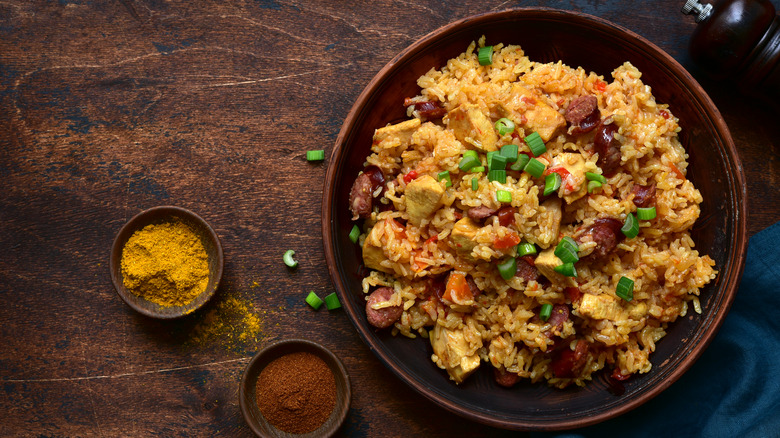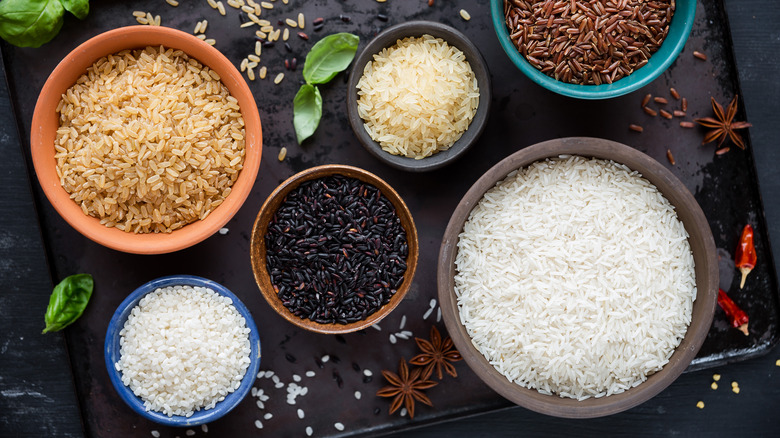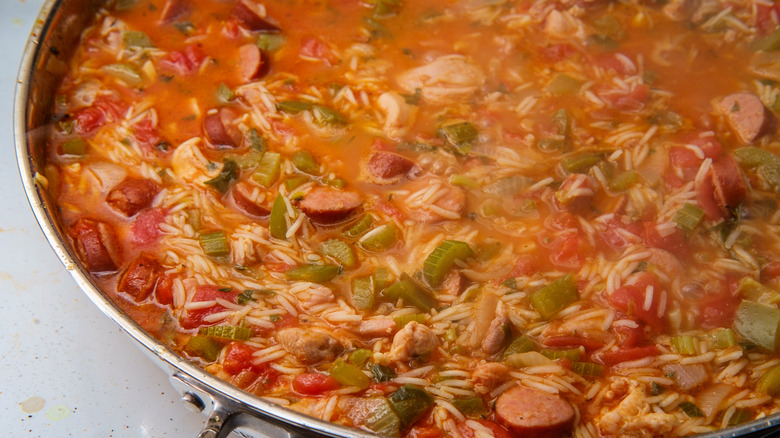The Best Rice To Use For Jambalaya
Not only does the word "jambalaya" sound like a party, but this dish tastes like one, too. This Louisiana classic is filled with chicken, sausage, seafood, vegetables, and lots of seasonings, but the base of the dish is sautéed-then-simmered rice. This is why you should never think that the rice isn't as important as everything else — just like in risotto and sushi, the right type of rice is essential to nailing the correcy texture for this dish.
Many agree that long-grain white rice is the ideal choice for jambalaya. This type of rice is light and fluffy, and when cooked correctly, it doesn't clump together. Jasmine and basmati rice are popular long-grain varieties, and both are good choices for jambalaya. These two breeds are naturally more flavorful and fragrant than plain, long-grain white rice, and will still absorb all of the wonderful flavors of the seafood, meat, spices, and aromatics.
One element of getting the rice just right in jambalaya is to avoid stirring it excessively. This releases the starch in the rice, and while that might be good for a basic risotto, it makes jambalaya mushy. Once the rice is combined with the cooking liquid and other ingredients, give everything a stir, cover the dish, and let the rice simmer and steam (without stirring it any more!) until it's done.
Not all rice is created equal
Just how much of a difference does the wrong type of rice make in jambalaya? To start off, we can look at short-grain rice, which is used to make risotto and sushi rice. The former is constantly stirred in order to release the starches, which is what makes risotto very rich and creamy. Sushi rice, on the other hand, is meant to be sticky so that it adheres to seaweed sheets, fish, and other ingredients. It also stays clumped together so you can pick it up with chopsticks when it's served in a bowl. Jambalaya made with short-grain rice would not be light and fluffy, but dense, gluey, and mushy.
Medium-grain rice, on the other hand, looks similar to short-grain rice. It cooks up moist, tender, and a little chewy, and also tends to stick together, rather than remain in separate grains. In many recipes, you can comfortably substitute medium-grain rice for short-grain, but not when a dish calls for long-grain varieties. Medium-rice makes excellent fried rice or mango coconut rice pudding, and is sometimes used to make risotto, but it's a "no" for jambalaya. When the rice is sticky, the dish feels less unified, as the grains won't be evenly distributed amidst the meat and veggies.
There are two types of jambalaya
Jambalaya is a true melting pot of a dish. It contains influences from several cultures, including Spanish, French, African, Native American, and Caribbean cuisine. While long-grain rice is always the best choice for any jambalaya recipe, there are actually two popular versions of this dish: Creole and Cajun. The basic difference between them is the inclusion of tomatoes.
Creole jambalaya is made with tomatoes, with some believing that it was the Spanish who introduced the ingredient to the New Orleans classic. In an effort to replicate their native paella — a similar dish of rice cooked with seafood and, notably, saffron — they added tomatoes to mimic the color of the rare spice, which was difficult to find in the southern United States. The tomatoes also add a slightly moister, more brothy consistency. Today, this red version of jambalaya is still most strongly associated with NOLA.
Meanwhile, Cajun jambalaya is brown in color, and does not include tomatoes. It gets its color from the initial caramelizing of the meat, which is blended into the whole dish when the water or broth is poured into the pot. In both versions of the dish, the rice is toasted in the pot for a moment before it's simmered to completion. On top of picking the right kind, this extra step can really heighten the flavor and aroma of your rice.



